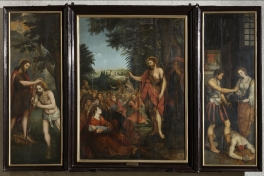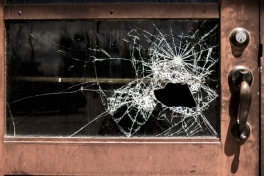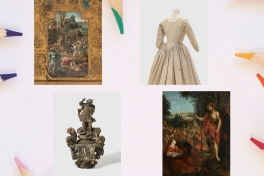Dag 3: Ethnographic collections, aspects of research, preservation and conservation | Summer school
Wannes Hubau, PhD in het Koninklijk Museum voor Midden-Afrika, Tervuren, startte de dag met een sessie over houtanatomie en identificatie. Eerst vertelde hij meer over hoe waardevol bomen zijn en waarom het belangrijk is om hout te identificeren, dit zowel in de commerciële markt als voor wetenschappelijk onderzoek. Hij legde uit dat werken met definities belangrijk is, net als werken met de wetenschappelijke naam. Het correct labelen van monsters betekent dat eerst de familienaam, dan de geslachtsnaam en als laatste de soortnaam worden vermeld.
Hij legde uit wat hout is en wat de verschillen zijn tussen hardhout en zachthout, op welke manier monsters worden gemaakt en welke microscopen gebruikt worden voor hout- en houtskoolidentificatie. Voor anatomische beschrijvingen wees hij op het boek 'IAWA list of microscopic features for hardwood identification' en de website insidewood.lib.ncsu.edu. Ook wees hij erop dat het Koninklijk Museum voor Midden-Afrika een referentiecollectie heeft die geraadpleegd kan worden.
Charles Indekeu, docent CR Studio Hout aan de Universiteit van Antwerpen, gaf een lezing over houtbewerking en bewerkingssporen op hout. Charles gebruikte iconografie om de verschillende werktuigen en de evolutie van houtbewerking aan te tonen door de eeuwen heen. Hij vertelde meer over hoe bewerkingssporen kunnen worden onderzocht op houten objecten en hoe deze sporen meer kunnen vertellen over hoe een houten object werd gemaakt. En dat het kan helpen in preventieve conservatie, om meer de beweging in hout en schadebeelden van het hout te verstaan.
Geert Van Eeckhout, o.a. docent Erfgoedstudies aan de Universiteit van Antwerpen, sprak over toxicologie bij etnografische objecten. Hij vertelde dat chronisch gevaar gevaarlijker is dan acuut gevaar doordat bij chronisch gevaar de schadelijke effecten niet direct zichtbaar zijn en deze hierdoor zwaar worden onderschat. Bij chronisch gevaar wordt er minder streng gehandeld dan bij acuut gevaar, net zoals in de wetgeving. Geert vertelde hierna meer over LD-dosis, alsook over de MAC-waarde (Maximum Allowable Concentration, die wordt toegepast in de EU) als over TLV-waarde (Threshold Limit Value, die wordt toegepast in Groot-Brittannië en de VS). Hierna vertelde hij meer over de gevaren bij etnografische collecties, zoals schimmels, insecten en pesticiden en welk effect deze kunnen hebben op het menselijk lichaam. Hij duidde dit via voorbeelden uit het werkveld.
Tijdens de middagpauze voerde Patrick Storme, docent van de CR Studio Metalen aan de Universiteit van Antwerpen, XRF-onderzoek uit op de etnografische objecten. De les over XRF-onderzoek zal op woensdag 30 augustus worden gegeven.
In de namiddag was er een praktijksessie. De studenten kregen de mogelijkheid om metalen monsters in te bedden alsook te slijpen en te polijsten onder supervisie van Mien Morren, docent van de CR Studio Metalen. De studenten kregen ook de kans om houtstalen te identificeren via referentiemateriaal dat Wannes Hubau, PhD in het Koninklijk Museum voor Midden-Afrika, meebracht. Ook konden ze onder toezicht van Charles Indekeu en Wannes Hubau een staal nemen van hun houten object om te onderzoeken.
English version
Wannes Hubau, Postdoctoral Research Fellow at the Royal Museum of Central Africa, Tervuren, gave the first session about wood anatomy and identification.
First he explained the value of the living trees and why it is important to identify wood species, for both the commercial market and for scientific research.
He explained the importance of definitions in order to label a sample correctly: first the family name, than the generic name and finally the species name. He also showed the importance of working with the scientific name and not the common name. He explained what wood is made off and told the differences in hardwoods and softwoods.
Than he explained more how samples are prepared and how to soften the wood, and showed the different research techniques that can be used. For anatomical description he pointed out the ‘’IAWA list of microscopic features for hardwood identification’ and the website insidewood.lib.ncsu.edu. Also the Royal Museum for Central Africa has a reference collection that can be consulted.
Charles Indekeu, teacher of the Wood Department at the University of Antwerp, talked more about traceology and woodworking. Charles used iconography to show the different working tools and the evolution of woodworking through time. He explained more about toolmarks on wooden objects: how they can be examined and how they can reveal more about the production of the object. All this can have a contribution towards preventive conservation, to understand more about the warping, cracking etc. of the wooden object.
Geert Van Eeckhout, lecturer of heritage at the University of Antwerp, told about toxicology in ethnographic objects. He explained the difference in acute danger and chronical danger. He noted that chronical danger is more dangerous because of the fact that hazardous effects are not always immediately noticeable. We are less cautious with those chronical hazards than with acute danger, even in legislation. Geert talked more about the LD dose, the MAC-value (the maximum allowable concentration used in the EU) and TLV-value (Threshold limit value used in the USA and GB). Than he explained the different hazards on ethnographical collections, like mould, insects and pesticides and what effects it can have on the human body. He illustrated with cases from the work field.
During lunch, Patrick Storme, teacher of the Metal Department at the University of Antwerp, did XRF-research on the ethnographical objects. The XRF lecture will be held on Wednesday 30th August.
In the afternoon there was a practical session. The students had the opportunity to try out to embed a metal sample and to grind and polish it by the assistance of Mien Morren, teacher of the Metal Department. The students also tried to identify wood samples by reference materials with the assistance of Wannes Hubau. Also the students had the opportunity to take a wood sample of their object and to identify with the assistance of Charles Indekeu and Wannes Hubau.






